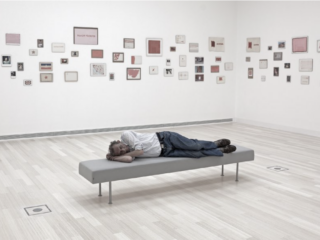Embracing pressure as a slingshot of creative expression
Depression, a topic often associated with somberness, also frequently intersects with the realm of creativity. While it might appear paradoxical in the context of the creative process, I believe there can be advantages in embracing depression as a force that enhances creative flow. It’s important to note that I am not a psychologist or trained in any medical capacity; my insights are based solely on personal experiences with depression.
To provide some enlightening context, I came across the work of Canadian physician and author Gabor Maté some time ago, and it profoundly altered my perception of depression. He highlighted a direct link between depression and suppression. Deconstructing the word “depression” itself reveals an act of literally being pushed down, a form of suppression, oppression, compression, or even repression of one’s true self. It signifies an internal struggle or external pressure that often hinders us from being our authentic selves. As Maté states:
“Authenticity is the capacity to know what you feel, to be in touch with our bodies, and to be able to express who we are and manifest who we are in our activities and in our relationships.”
This appears to be increasingly prevalent in an era marked by immeasurable and imperceptible complexity, amid the seismic ebb and flow of experiential pressures. For creative individuals, this suppression can significantly disrupt the harmonious flow of creativity, giving rise to intense, conflicting, and frequently sombre emotions. However, for me, comprehending some of these underlying causes and ‘mechanics’ of depression offers almost tangible insights into embracing it, not as a force of debilitation or despair, but rather as an embodied messaging system.
In my experience, Depression is all too often treated as an enigmatic force, wrapped in labyrinthine social and health connotations, often presented as a disorder, a dysfunction. A label of ambiguity whose terms and myriad of ‘treatments’ can leave the individual feeling more overwhelmed and on a journey of perpetuated disorientation and punishment, which is completely unnecessary. But if we understand that the feelings of being depressed merely serve as an instinctive signal, indicating that something is acutely amiss, for which a natural response is feeling low, disempowered, or lacking motivation, and too often, purpose. In a world that relentlessly promotes the veneer of positivity and has commoditized the constant pursuit of happiness, understanding our embodied spectrum of emotions can be crucial in making sense of reality.
Historically, a preponderance of highly creative individuals have wrestled with conveying their vivid experiences with depression, whether through writing or art, etc. It’s a phenomenon which is beginning to be attributed, in part, to the heightened levels of sensitivity of creatives to their surroundings. We are attuned to nuances, making us more susceptible to the ebbs and flows of emotions, and very often act as a canary in the coal mine or a sponge for the detrimental forces of the man-made paradigms that envelop us. But as creatives, if we can rise beyond the fog of overwhelm, we can often discover a unique ability to objectify these forces for what they are and embrace the subsequent forces of ‘depression’ as a means of broadening and challenging these paradigms through creative expression.
Creativity in itself can be an intangible journey of emotions, where the vivid contrasts of joy and sadness often clash and collide. These are instincts akin to indicating good vs bad, nice vs grim, safe vs danger, etc. Fully functioning impulses that come alive when exploring uncharted territory and creating new spaces. It’s a delicate and often nerve-racking dance, much like the journey portrayed in the film ‘The Revenant’ (based on the novel by American author Michael Punke). This vivid and wild portrayal of the American frontiersman Hugh Glass in 1823 Missouri, while seemingly a tale of intense struggle for survival, offers a profound perspective on the creative process.
In a world where the relentless pursuit of happiness can sometimes resemble a modern form of bondage, ‘The Revenant’ serves as a poignant reminder that our deep creative instincts have always emerged from the act of forging new ground, reshaping perceptions, fostering different attitudes, modes of acceptance, and objectivity. Moreover, it challenges the notion that depression, while undoubtedly a genuine experience for many, is merely a construct of our modern social context. It invites us to critique it in novel and creative ways, far beyond the realm of pharmaceutical solutions.
This cinematic journey shines a vivid light on our society’s addiction to, or dependence on, happiness, which can be seen as a contemporary manifestation of enslavement. In Glass’s world, there are no quick fixes, no antidepressants, and no therapists. Similarly, perhaps we should confront our own reliance on fleeting happiness and instead embrace the wilderness of human emotion and creativity. Just as Glass’s survival instincts compel him to devise solutions, creatives can harness the depths of their emotions to innovate and create.
The Revenant broadens our periphery and perception of happiness and sadness. It encourages us to reconsider these emotions not as polar opposites but as nuances on a spectrum, much like Glass battles not only the elements but also his own demons. In a world where the pursuit of happiness can sometimes resemble a modern form of bondage, Glass’s instinctive and innovative pursuit of survival serves as a testament to the creative process. He inadvertently embodies the darkness as a slingshot to propel himself toward the next adjacent challenge, carving out potential rather than wallowing in loss or perceived darkness.
Depression can be approached by a creative spirit with curiosity, devoid of fear, and armed with context. By doing so, the forces of depression can become an unconventional slingshot for creativity, empowering the exploration of uncharted emotional realms often shunned by the risk-averse. This journey serves as a testament to the creative ability to articulate and share complex feelings.
This perspective encourages us to view depression not solely as a burden but as a facet of the human experience. It is a signal, a sensation of suppression that, for creatives, can serve as a source of inspiration. Understanding its origins and embracing it as a creative subject can lead to a deeper understanding of ourselves and the world around us, highlighting the resilience and creativity of the human spirit, which is increasingly diminished in an ever-tabulated and over-strategised world.
Deep creativity exists not to conform to the chains of obscure and often harmful societal expectations, but to challenge and defeat them.




